power steering TOYOTA TUNDRA 2011 2.G Owners Manual
[x] Cancel search | Manufacturer: TOYOTA, Model Year: 2011, Model line: TUNDRA, Model: TOYOTA TUNDRA 2011 2.GPages: 732, PDF Size: 16.65 MB
Page 2 of 732

TABLE OF CONTENTSIndex
2
1-1. Key informationKeys ..................................... 42
1-2. Opening, closing and locking
the doors
Wireless remote control ....... 44
Side doors ............................ 47
Tailgate ................................ 52
1-3. Adjustable components
(seats, mirrors, steering
wheel)
Front seats ........................... 58
Rear seats (Double Cab and CrewMax models) ....... 63
Driving position memory (driver’s seat) ..................... 68
Head restraints ..................... 71
Seat belts ............................. 75
Steering wheel (manually adjustable type) .................. 83
Steering wheel (power-adjustable type)...... 85
Anti-glare inside rear view mirror .................................. 86
Outside rear view mirrors ..... 89
1-4. Opening and clos ing
the win dows and moon roof
Power windows .................... 94
Back window ........................ 98
Power back window ............. 99
Moon roof ........................... 102 1-5. Refueling
Opening the fuel tank cap... 107
1-6. Theft deterrent system Engine immobilizer system .............................. 112
Alarm .................................. 114
1-7. Safety information Correct driving posture ....... 117
SRS airbags ....................... 119
Front passenger occupant classification system ......... 135
Child restraint systems ....... 142
Installing child restraints ..... 148
2-1. Driving procedures Driving the vehicle .............. 172
Engine (ignition) switch....... 181
Automatic transmission ...... 184
Turn signal lever ................. 189
Parking brake ..................... 190
Horn .................................... 191
2-2. Instrument cluster Gauges and meters ............ 192
Indicators and warning lights ................................. 198
Multi-information display ..... 203
Accessory meter ................. 209
1Before driving
2When driving
Page 41 of 732
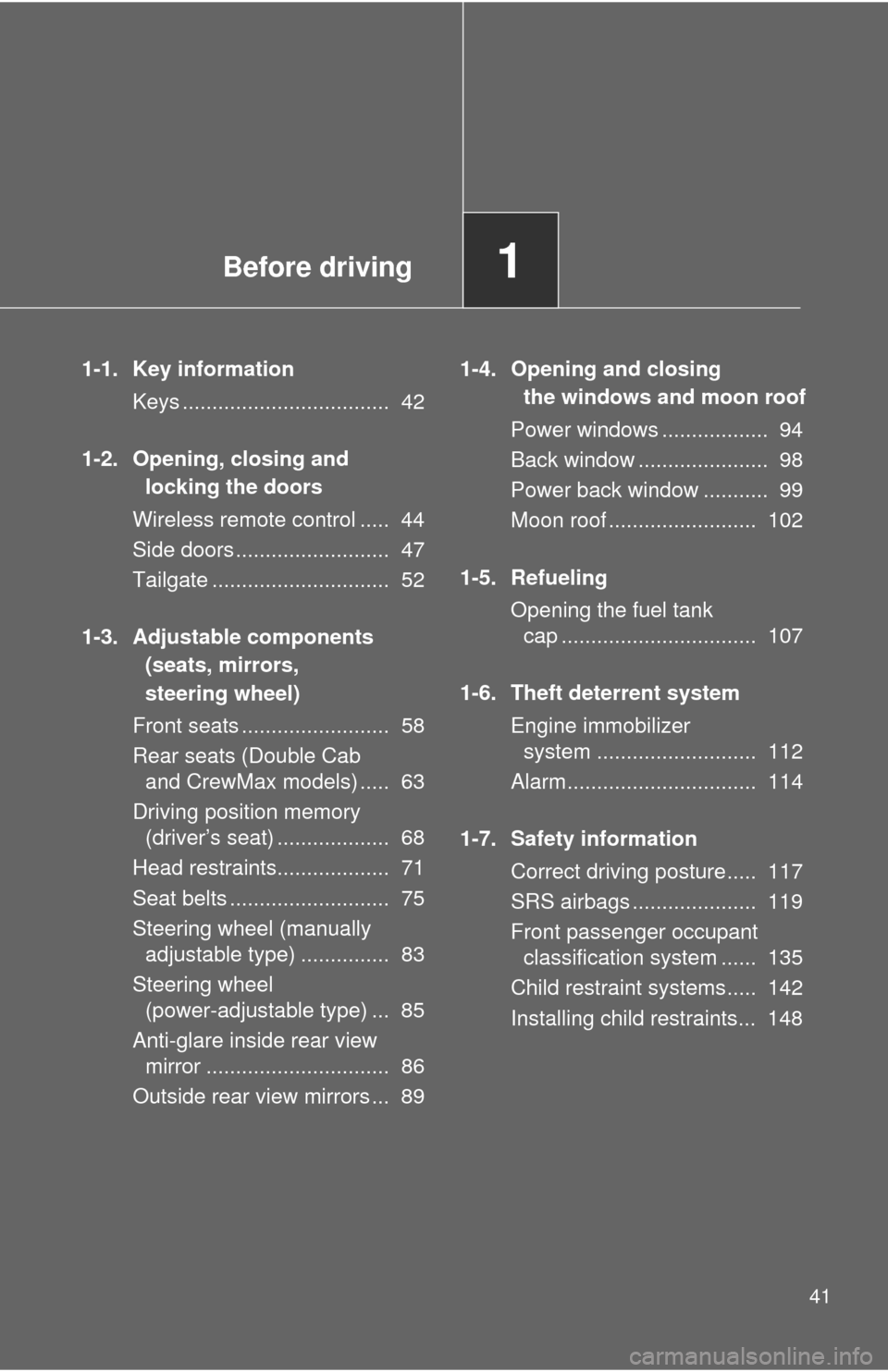
Before driving1
41
1-1. Key informationKeys ................................... 42
1-2. Opening, closing and locking the doors
Wireless remote control ..... 44
Side doors .......................... 47
Tailgate .............................. 52
1-3. Adjustable components (seats, mirrors,
steering wheel)
Front seats ......................... 58
Rear seats (Double Cab and CrewMax models) ..... 63
Driving position memory (driver’s seat) ................... 68
Head restraints................... 71
Seat belts ........................... 75
Steering wheel (manually adjustable type) ............... 83
Steering wheel (power-adjustable type) ... 85
Anti-glare inside rear view mirror ............................... 86
Outside rear view mirrors ... 89 1-4. Opening and closing
the windows and moon roof
Power windows .................. 94
Back window ...................... 98
Power back window ........... 99
Moon roof ......................... 102
1-5. Refueling Opening the fuel tank cap ................................. 107
1-6. Theft deterrent system Engine immobilizer system ........................... 112
Alarm................................ 114
1-7. Safety information Correct driving posture..... 117
SRS airbags ..................... 119
Front passenger occupant classification system ...... 135
Child restraint systems..... 142
Installing child restraints... 148
Page 60 of 732
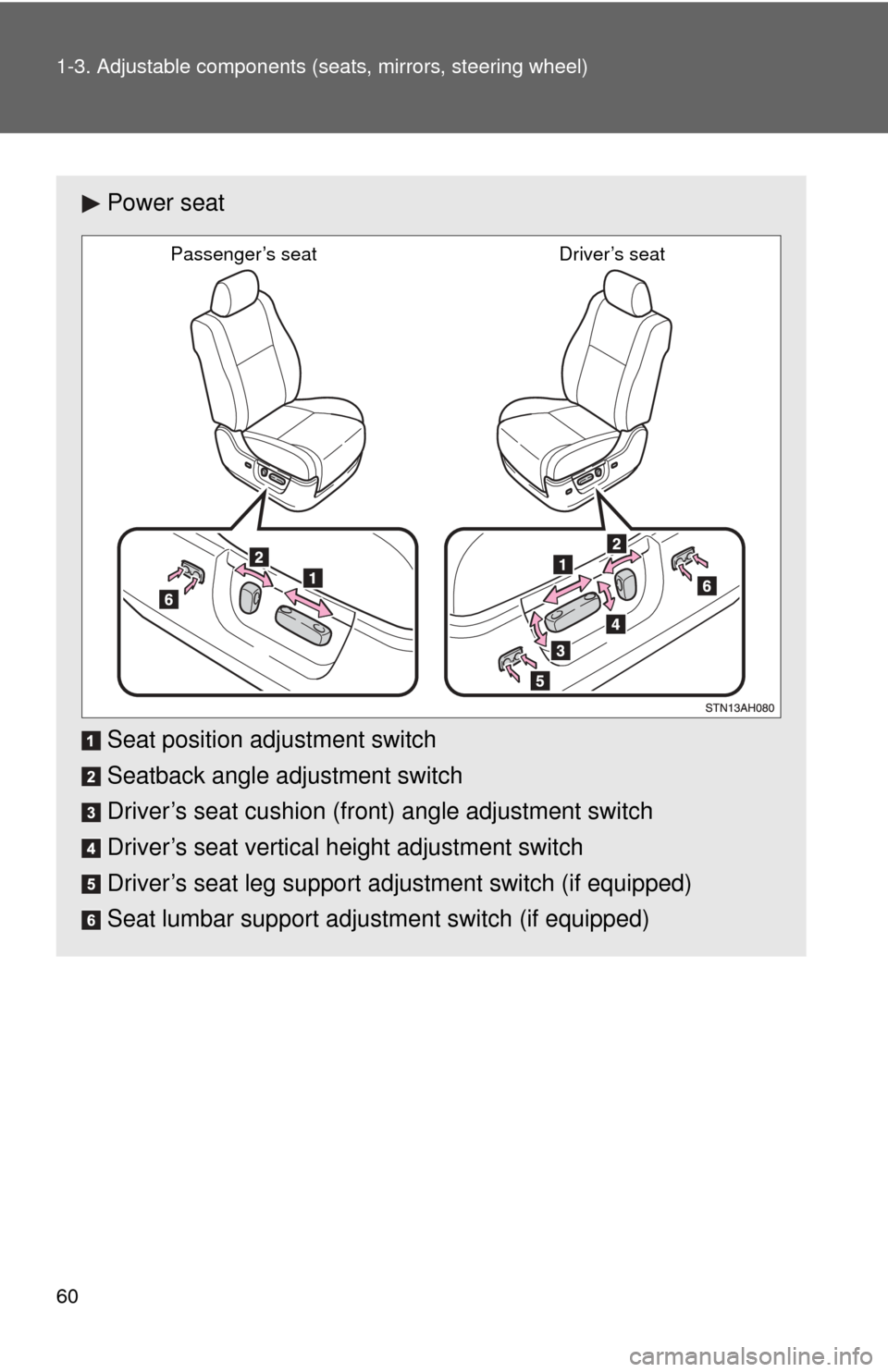
60 1-3. Adjustable components (seats, mirrors, steering wheel)
Power seat
Seat position adjustment switch
Seatback angle adjustment switch
Driver’s seat cushion (front) angle adjustment switch
Driver’s seat vertical height adjustment switch
Driver’s seat leg support adjustment switch (if equipped)
Seat lumbar support adjustment switch (if equipped)
Passenger’s seat Driver’s seat
Page 70 of 732

70 1-3. Adjustable components (seats, mirrors, steering wheel)
■Retained accessory power
Each memorized position (except for the tilt and telescopic steering column)
can be activated within 30 seconds after the driver’s door is opened, even if
the key is not in the engine switch.
■ If any position memory button is pushed while the adjustments are
being made
The operation will stop. To reactivate the system, push the button (“1” or “2”)
again.
■ If the battery is disconnected
The memorized positions must be reset because the computer’s memory is
erased when the battery is disconnected.
CAUTION
■Seat adjustment caution
Take care during seat adjustment that the seat does not strike the rear pas-
senger or squeeze your body against the steering wheel.
If this happens, you can stop the movement by pressing another seat posi-
tion memory button.
Page 85 of 732
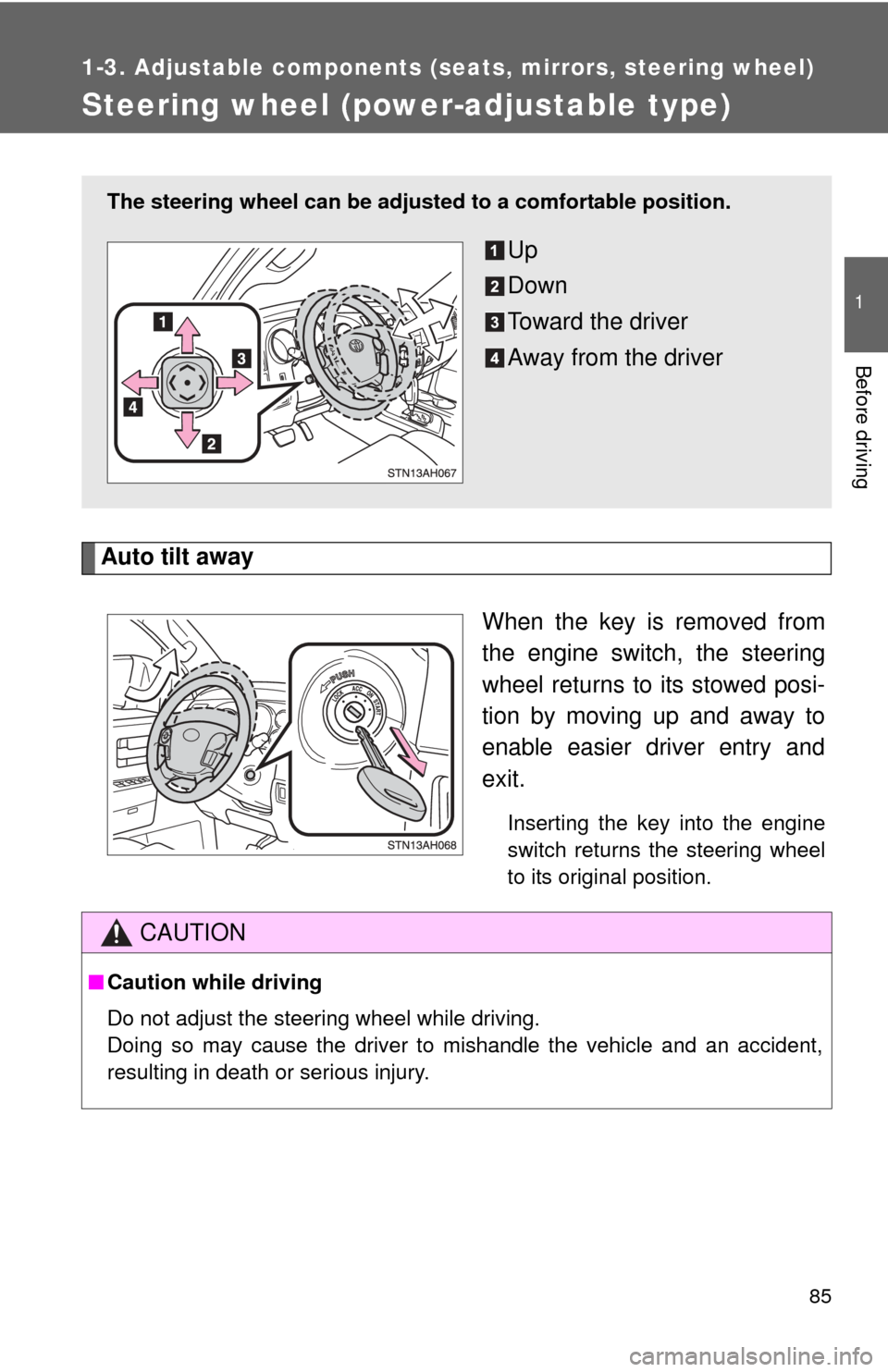
85
1
1-3. Adjustable components (seats, mirrors, steering wheel)
Before driving
Steering wheel (power-adjustable type)
Auto tilt awayWhen the key is removed from
the engine switch, the steering
wheel returns to its stowed posi-
tion by moving up and away to
enable easier driver entry and
exit.
Inserting the key into the engine
switch returns the steering wheel
to its original position.
The steering wheel can be adjusted to a comfortable position.
Up
Down
Toward the driver
Away from the driver
CAUTION
■Caution while driving
Do not adjust the steering wheel while driving.
Doing so may cause the driver to mishandle the vehicle and an accident,
resulting in death or serious injury.
Page 89 of 732
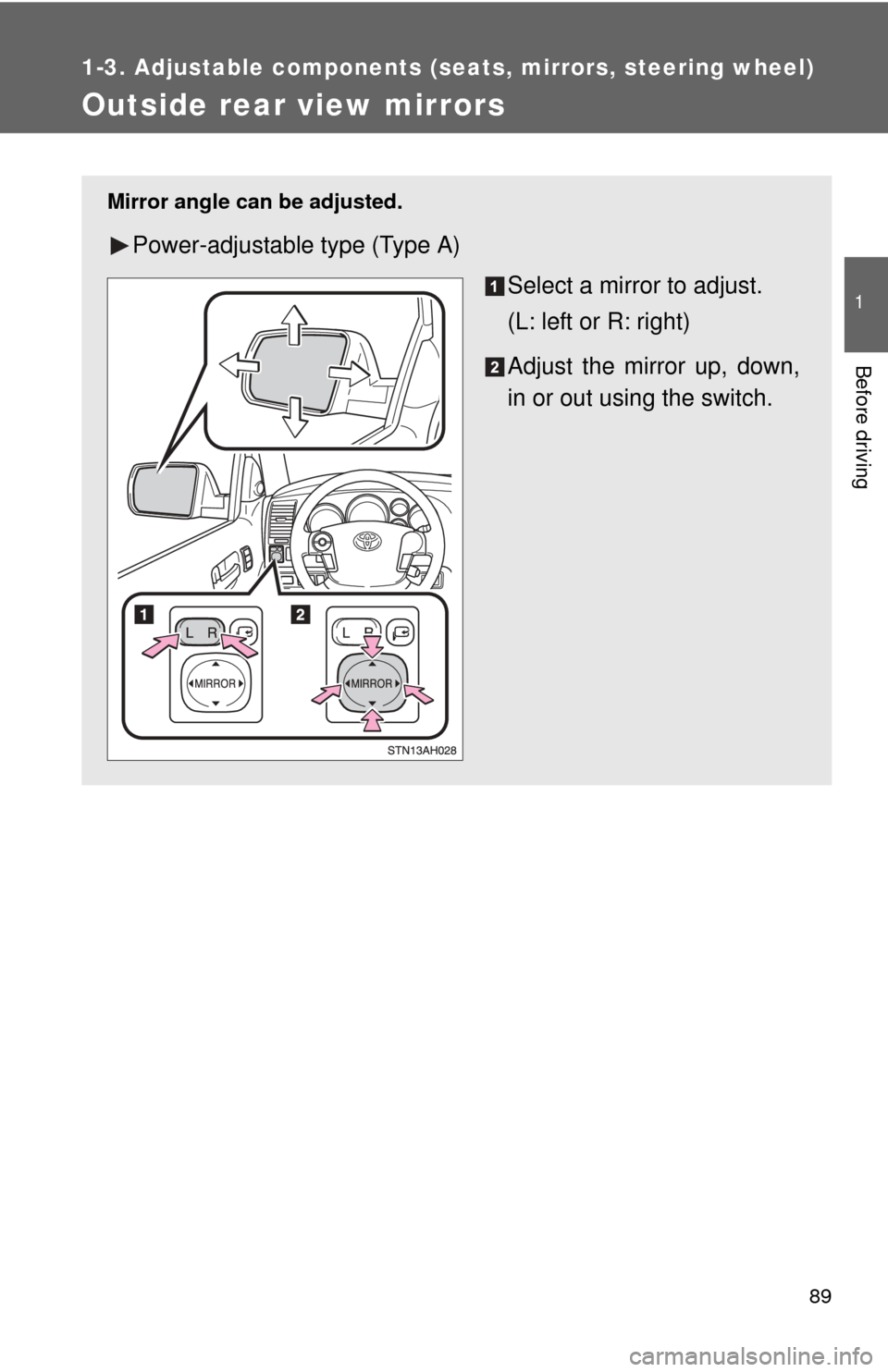
89
1
1-3. Adjustable components (seats, mirrors, steering wheel)
Before driving
Outside rear view mirrors
Mirror angle can be adjusted.
Power-adjustable type (Type A)
Select a mirror to adjust.
(L: left or R: right)
Adjust the mirror up, down,
in or out using the switch.
Page 90 of 732
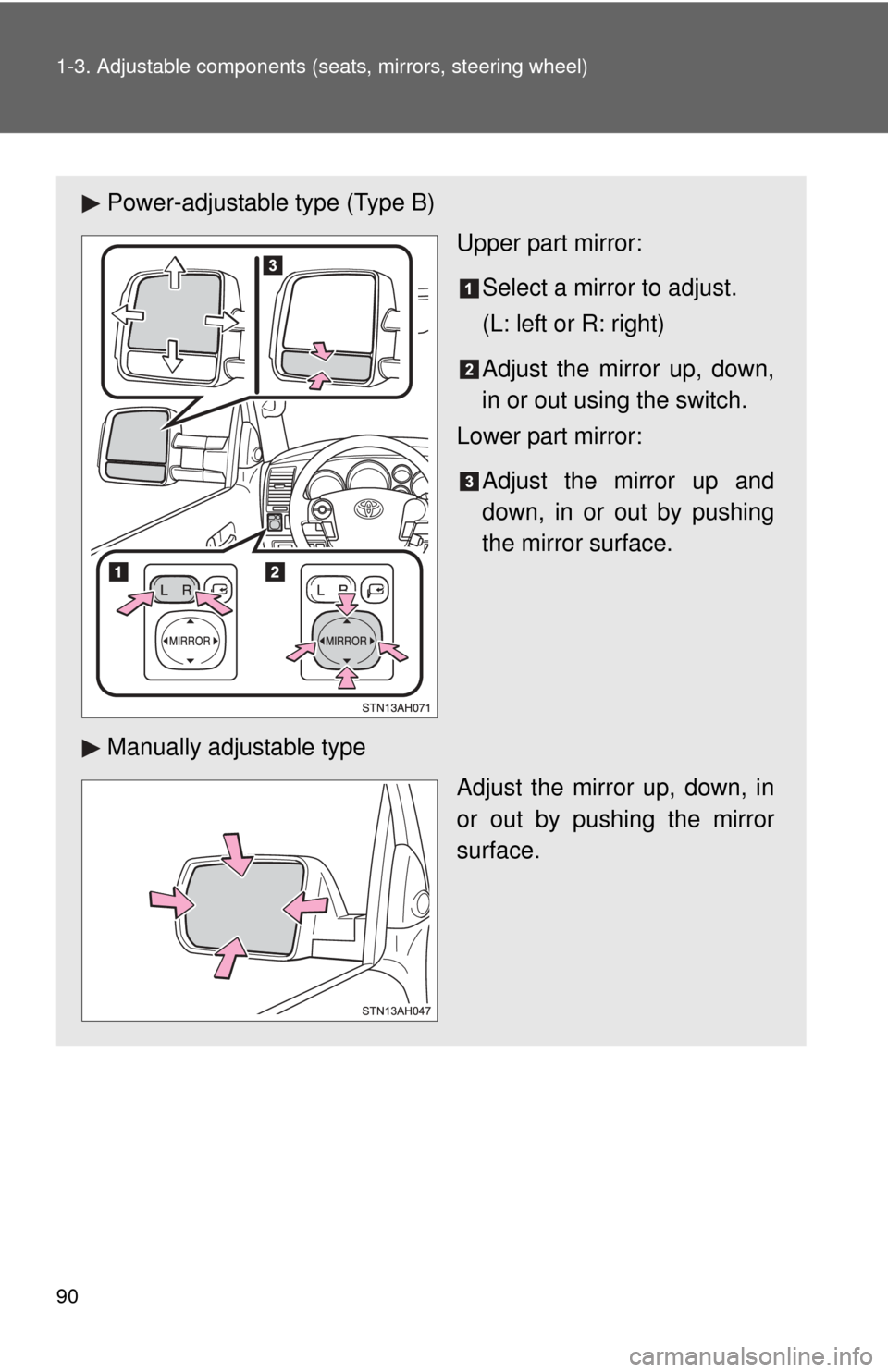
90 1-3. Adjustable components (seats, mirrors, steering wheel)
Power-adjustable type (Type B)
Upper part mirror:
Select a mirror to adjust.
(L: left or R: right)
Adjust the mirror up, down,
in or out using the switch.
Lower part mirror:
Adjust the mirror up and
down, in or out by pushing
the mirror surface.
Manually adjustable type Adjust the mirror up, down, in
or out by pushing the mirror
surface.
Page 92 of 732
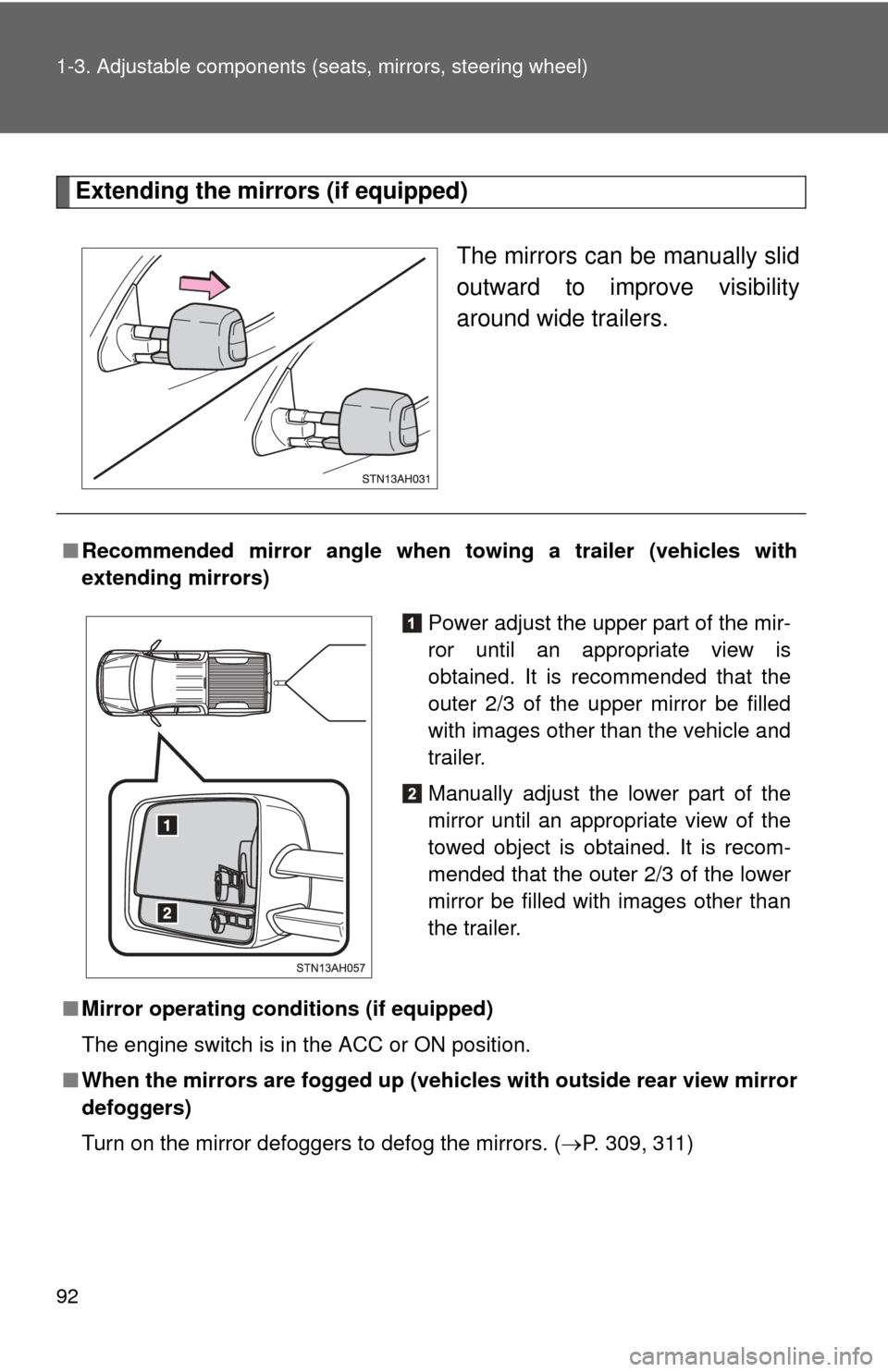
92 1-3. Adjustable components (seats, mirrors, steering wheel)
Extending the mirrors (if equipped)
The mirrors can be manually slid
outward to improve visibility
around wide trailers.
■Recommended mirror angle when towing a trailer (vehicles with
extending mirrors)
■ Mirror operating conditions (if equipped)
The engine switch is in the ACC or ON position.
■ When the mirrors are fogged up (veh icles with outside rear view mirror
defoggers)
Turn on the mirror defoggers to defog the mirrors. ( P. 309, 311)
Power adjust the upper part of the mir-
ror until an appropriate view is
obtained. It is recommended that the
outer 2/3 of the upper mirror be filled
with images other than the vehicle and
trailer.
Manually adjust the lower part of the
mirror until an appropriate view of the
towed object is obtained. It is recom-
mended that the outer 2/3 of the lower
mirror be filled with images other than
the trailer.
Page 122 of 732

122 1-7. Safety information
■SRS warning light
This warning light system monitors the airbag sensor assembly, front airbag
sensors, side and curtain shield airbag sensor assemblies, curtain shield air-
bag sensor assemblies, driver’s seat position sensor, driver’s seat belt
buckle switch, front passenger occupant classification system, AIR BAG ON
and AIR BAG OFF indicator lights, front passenger’s seat belt buckle switch,
passenger airbag off switch (Regular C ab models), front seat belt preten-
sioner assemblies, RSCA OFF indicator light, inflators, interconnecting wir-
ing and power sources. ( P. 600)
■ If the SRS airbags deploy (inflate)
●Bruising and slight abrasions may result from contact with a deploying
(inflating) SRS airbag.
● A loud noise and white powder will be emitted.
● Parts of the airbag module (steering wheel hub, airbag cover and inflator)
as well as the front seats, and parts of the front and rear pillars and roof
side rail, may be hot for several minutes. The airbag itself may also be
hot.
● The front windshield may crack.
■ Operating conditions (front airbags)
● The SRS front airbag will deploy in the event of an impact that exceeds
the set threshold level (the level of force corresponding to an approxi-
mately 12-18 mph [20-30 km/h] frontal collision with a fixed wall that does
not move or deform).
However, this threshold velocity will be considerably higher if the vehicle
strikes an object, such as a parked vehicle or sign pole, which can move or
deform on impact, or if the vehicle is involved in an underride collision (e.g.
a collision in which the front of the vehicle “underrides”, or goes under, the
bed of a truck, etc.).
● It is possible that in some collisions where the forward deceleration of the
vehicle is very close to the designed threshold level, the SRS front air-
bags and the seat belt pretensioners may not activate together.
● The SRS front passenger airbag will not activate if there is no passenger
sitting in the right front passenger seat. However, the front passenger air-
bag may deploy if luggage is put in the seat, or the seat belt is fastened,
even if the seat is unoccupied. ( P. 135)
Page 175 of 732

175
2-1. Driving procedures
2
When driving
CAUTION
■
When driving the vehicle
●Do not under any circumstances shift the shift lever to P, R or N while the
vehicle is moving.
Doing so can cause significant damage to the transmission system and
may result in a loss of vehicle control.
● Do not shift the shift lever to N while the vehicle is moving.
Doing so may cause the engine brake to not operate properly and lead to
an accident.
● Do not turn the engine off while driving.
The power steering and brake booster systems will not operate properly if
the engine is not running.
● Use engine braking (downshift) to maintain a safe speed when driving
down a steep hill.
Using the brakes continuously may cause the brakes to overheat and lose
effectiveness. ( P. 184)
● When stopped on an inclined surface, use the brake pedal and parking
brake to prevent the vehicle from rolling backward or forward and causing
an accident.
● Do not adjust the position of the steering wheel, the seat, or the inside or
outside rear view mirrors while driving.
Doing so may result in a loss of vehicle control that can cause accidents
that may result in death or serious injury.
● Always check that all passengers’ arms, heads or other parts of their bod-
ies are not outside the vehicle, as this may result in death or serious injury.
● Do not drive in excess of the speed limit. Even if the legal speed limit per-
mits it, do not drive over 85 mph (140 km/h) unless your vehicle has high-
speed capability tires. Driving over 85 mph (140 km/h) may result in tire
failure, loss of control and possible injury. Be sure to consult a tire dealer
to determine whether the tires on your vehicle are high-speed capability
tires or not before driving at such speeds.